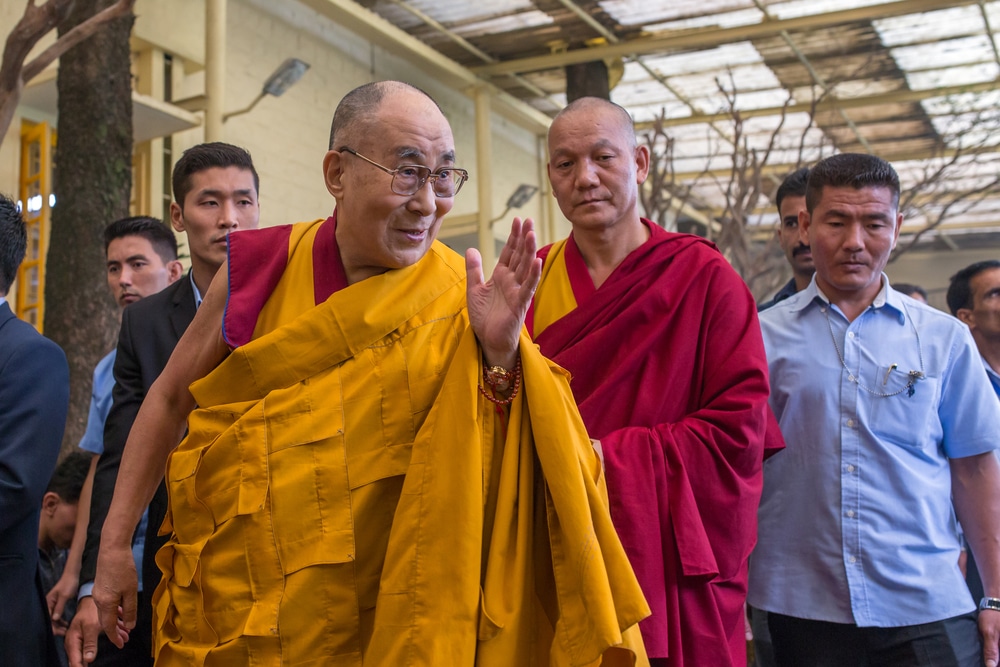 I hear so many questions from beginners questioning their ability to meditate.
I hear so many questions from beginners questioning their ability to meditate.
“I’d like to meditate but can’t seem to turn my mind off.”
“I know there are so many benefits of meditation. But where do I begin?”
“I’m no spiritual guru. Can I really meditate?”
“When do I get to levitate?”
Okay, maybe the last one isn’t exactly a beginner’s question. But so often beginners in meditation are intimidated and wonder where to begin.
While there are many books on the subject, starting out can seem daunting. Many are just looking for advice, tips, and tricks regarding meditation.
Simply put, they are looking for a guide. They are looking for a spiritual guru.
Are you one of these beginners in meditation looking for a spiritual guru?
Let’s help you find one.
How Do I Find My Spiritual Guru?
Zen Master Dogen wrote: “Look for Buddha outside your own mind, and Buddha becomes the devil”
Maybe the best start to finding a spiritual guru is in understanding what exactly a spiritual guru is.
What is a Spiritual Guru?
A guru is someone who is a teacher, guide, expert, or master of certain knowledge or field.
Unfortunately, there is a world of misunderstanding about spiritual gurus and their place in meditation practice and training. A certain amount of caution is wise.
At worst, a spiritual guru can be a charlatan or fake. A spiritual guru can be one using manipulation and trickery to obtain gifts and wealth from their unsuspecting students.
At best, a spiritual guru can deliver the student toward enlightenment and peace.
While there may be questions about the motives of some teachers, there can be no doubt that human history has been changed by the work of many gifted meditation teachers.
Who Are Famous Meditation Gurus?
As you already know, there is no shortage of teachers when beginning a meditation practice. Techniques and processes vary in styles as much as the personalities of the teachers who perfected them.
Here’s a cross-section of six spiritual gurus who have helped millions to achieve peace, enlightenment, and personal power:
1. Ram Dass
American spiritual teacher Ram Dass continues to teach around the world and continues to inspire many with his meditation teachings and practice.
He famously said:
“The cosmic humor is that if you desire to move mountains and you continue to purify yourself, ultimately you will arrive at the place where you are able to move mountains.”
Spiritual guru fact: Apple mastermind Steve Jobs swore by the book Be Here Now by Ram Dass.
You can see other spiritual books the mind behind the iPhone credited with his success here.
In fact, some Buddhists believe Steve Jobs has been reincarnated as a “celestial warrior-philosopher.
Maybe Mr. Jobs will make the list as a spiritual guru himself in the future.
2. Buddha
Born hundreds of years before Christ, many recognize the Buddha immediately as a master of meditation and a teacher of spiritual principles.
A true spiritual guru, the Buddha is quoted as saying:
“All that we are is the result of what we have thought.”
Centering our minds in peace is one of the many fruits of a regular meditation practice. World leaders, famous athletes, and beginners of all ages have turned to the Buddha’s teachings as a great place to begin.
3. Jesus
While some debate the place of meditation versus prayer within the Christian faith there is no doubt Jesus was a spiritual master of unparalleled power and inspiration.
Many Christians, and people of all faiths, practice meditation by reciting The Saint Francis Prayer over and over again, searching for its inner meaning.
Christian contemplative techniques were developed by the Desert Fathers, a group of ascetics that lived in what is now the Nitrian desert, beginning around 300AD. “Centering Prayer,” though popularised mainly by modern Trappist monks like Thomas Merton and Thomas Keating, is also seen as deriving from these ancient practices.
Benefits
- The method of centering prayer strongly resembles the practice outlined by Herbert Benson, one of the earliest scientifically-trained advocates of meditation, in his book The Relaxation Response. Consequently, it leads to a host of healing physiological responses.
- The use of a mantra curtails the incessant activity of the thinking mind. By stepping out of discursive thought, you’ll more easily lend yourself to the transformative power of silence.
- It’s an utterly simple practice that can be done anywhere.
Jesus Meditation: Technique
- Seat yourself comfortably with your eyes closed.
- Choose a sacred, two-syllable word. In this case, “Jesus.” (Although any will work fine.)
- As you breathe in say the first syllable of the word to yourself.
- Breathing out say the second syllable.
- It can be said silently to yourself, whispered on the breath or even out loud.
- If you find yourself caught up in thoughts, return your attention to the utterance of the syllable on your breath.
Tips
- The theological and psychological basis of “Centering Prayer” is developed at length by many Christian contemplatives in their books, CDs, and seminars. If you wish to integrate this practice more deeply into your spiritual path, then there are a great many resources to help you do so.
- If you prefer another mantra, use it. There are no strict rules guiding which “sacred” word should be used. The point is to pick one that symbolizes your intent to surrender, to relax, to open yourself to the work of the Divine.
- You can use this meditation when you need to relax. Not only is the meditative method a well-proven path to calm but the use of the mantra “Jesus” can also instill positive emotions.
As with many spiritual masters, Jesus preached finding the strength and power to live the fullest life inside ourselves through introspection:
“The kingdom of God is within you.” (Luke 17:21)
4. Eckhart Tolle
Tolle, another contemporary teacher, proves once again that a beginner can find their spiritual guru right now, today.
A teacher of change, and the fundamental benefits of meditation for daily life, Tolle says:
Finding a great spiritual guru can help one change for the better.
5. Rumi
If you’re reading this on the internet, you’ve heard of Rumi.
Rumi, the famous Sufi mystic, has inspired generations with his poetry and meditations.
The book, A Year With Rumi: Daily Readings would give any beginner enough fuel for a meditative life to begin blooming.
6. Dalai Lama
Feel discouraged? Getting overwhelmed?
Do you wonder with all these teachers, and all these spiritual gurus, if you will ever find a place to begin? Will it always be so difficult to meditate and to understand how best to meditate?
How about some inspiration on meditation from a living spiritual guru, the Dalai Lama himself:
“After doing daily for 60 years, it is still hard,” he says.
Of course, there are no shortages of contemporary meditation spiritual gurus one can follow the teachings of. Some of them even changed the history of meditation in the western world.
Which Spiritual Guru Do I Choose?
The answer, as with all spiritual journeys, is inside of you.
As our friend Dorothy from The Wizard of Oz came to realize, the power was right with her the entire time.
While there are hundreds of teachers, countless spiritual gurus, and numerous books and techniques, one thing is for certain:
You can begin, right where you are, at any time.
Just close your eyes and breathe.
What’s more: Following one spiritual guru doesn’t mean you are stuck with a single technique.
Experiment, keep searching and find a spiritual guru who is right for you.
And then find another one. The greatest teachers have taught us that the joy is in the journey itself.
Just close your eyes and breathe.
Purchasing meditation balls, incense, music, and shawls have helped many to achieve a meditative state when beginning meditation, or when moving toward more advanced techniques.
In addition, a meditation retreat may help beginners get closer to the teachings of a certain spiritual guru or meditation discipline.
Definitive Spiritual Guru List: 10 Teachers to Learn From
Spirituality teachers are a bit like old cardigans. We’ve all got our favorite and they’re a unique and individual source of comfort to us. With that in mind, this list is in a sense a personal one.
I should really have phrased the title, “Ten Spiritual Teachers to Learn From in 2014 In My Opinion”. It just didn’t have quite the same ring….
Matthieu Ricard, “The Happiest Man in the World”
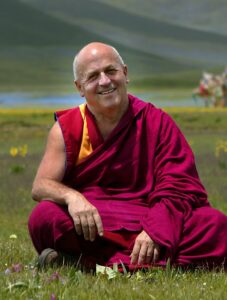 If you haven’t watched the documentary Mystical Brain, I highly recommend you do. In it, you can see French Buddhist monk Matthieu Ricard having hundreds of sensors attached to his head for the purpose of monitoring his brain-wave activity.
If you haven’t watched the documentary Mystical Brain, I highly recommend you do. In it, you can see French Buddhist monk Matthieu Ricard having hundreds of sensors attached to his head for the purpose of monitoring his brain-wave activity.
The MRI scan showed that activity in his pre-frontal cortex, the area associated with positivity, was at the highest level ever recorded in the scientific literature.¹
He has given many talks and written numerous books, the most famous of which is likely The Art of Meditation. He co-authored The Monk and the Philosopher with his father, the intellectual Jean-Francois-Revel.
The 14th Dalai Lama, Tenzin Gyatso
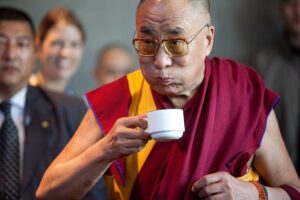 The jovial personae of the 14th Dalai Lama, an image firmly fixed in the Western imagination, isn’t as pristine as we might think.
The jovial personae of the 14th Dalai Lama, an image firmly fixed in the Western imagination, isn’t as pristine as we might think.
As a student, I was a big fan of the work of Christopher Hitchens. His treatises against public figures like Mother Theresa and Gandhi are notorious. The 14th Dalai Lama, too, is far from a perfect character.
But everything has its shades of dark and light. I have no doubt that the Dalai Lama is a truly compassionate human being and his books and many collaborations have contributed immensely to the Western understanding of Buddhism and the popularity of meditation.
Ken Wilber
 Wilber’s teachings have no doubt helped form an intelligent Western understanding of Eastern ideas. His life’s work has been developing what he calls, “Integral Theory,” a synthesis of many different disciplines (essentially a “Theory of Everything”).
Wilber’s teachings have no doubt helped form an intelligent Western understanding of Eastern ideas. His life’s work has been developing what he calls, “Integral Theory,” a synthesis of many different disciplines (essentially a “Theory of Everything”).
His ideas have received some attention in the academic community. I recommend the book Essential Ken Wilber: An Introductory Reader.
In 1985 he caught a very rare and unusual disease called RNase Enzyme Deficiency disease, which causes long periods of paralysis. Despite his affliction, he has continued to maintain a prodigious output of written work.
Thomas Keating
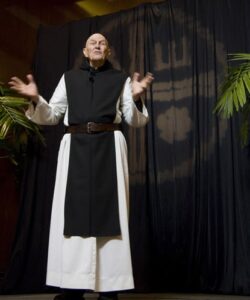 The contemplative tradition of Christianity is gaining much more exposure now than it ever previously has. This is in no small part thanks to the work of Thomas Keating. The method of Centering Prayer, which he has popularized, is simple and pragmatic.
The contemplative tradition of Christianity is gaining much more exposure now than it ever previously has. This is in no small part thanks to the work of Thomas Keating. The method of Centering Prayer, which he has popularized, is simple and pragmatic.
A contemporary of Thomas Merton, and a member of the Cistercians, he is probably the best-known Christian mystic. I think that individuals like Keating represent an interesting and hitherto largely hidden dimension of modern Western spirituality.
Jon Kabat-Zinn
Kabat-Zinn has been a leading force in integrating mind-body practices with psychotherapy. He developed the Mindfulness-Based-Stress-Reduction (MBSR) programme and teaches it around the world. His most famous book is probably Full Catastrophe Living: Using the Wisdom of Your Body and Mind to Face Stress, Pain, and Illness.
He is a prominent member of the Mind & Life Institute, which is the world’s biggest organization dedicated to exploring the middle-ground between contemplative traditions and modern science, what B. Alan Wallace has called, “Contemplative Science.”
Eckhart Tolle
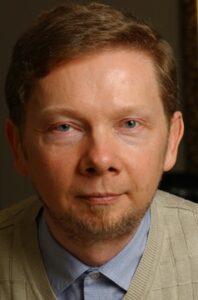 If for no other reason than the breadth of his reach, Eckhart Tolle needs to be on this list. After having a life-altering experience at the age of 29, Eckhart became homeless and spent the next two years sleeping on London park benches.
If for no other reason than the breadth of his reach, Eckhart Tolle needs to be on this list. After having a life-altering experience at the age of 29, Eckhart became homeless and spent the next two years sleeping on London park benches.
In The Power of Now he recalls experiencing, “Unimaginable levels of bliss,” in this period.
I attended a talk of his in London and it was the simplicity and secular tone of his teachings that initially drew me to him. You can keep up to date with his lectures on a monthly basis at Eckhart Tolle TV. If you’re stretched for time and looking for spiritual guidance, Eckhart is one of the easiest people to learn from.
Thich Nhat Hanh
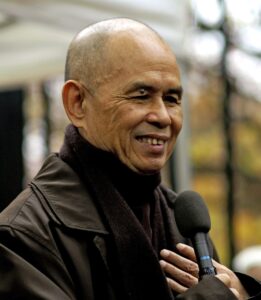 “Peace is every step.
“Peace is every step.
The shining red sun is my heart.”
Possibly the best-known monk in the West after the Dalai Llama. Thich Nhat Hanh is the leader of the Plum Village, the largest Buddhist monastery in Europe.
He is responsible for coining the term, “Engaged Buddhism.” If you have the opportunity, read his, “Five Mindfulness Trainings.”
Satish Kumar
Satish Kumar has led an extraordinary life. At the age of eight, he became a Jain monk. Ten years later he ran away to work as a land reformer before undertaking a peace-walk, barefoot, from India to America via Europe so that he could deliver packets of peace tea to the leaders of the world’s nuclear powers. His book No Destination, chronicling his 8000-mile walk, is a fascinating read.
Tara Stiles
 Tara’s company Strala focuses primarily on the health benefits of yoga (she promotes programmes for weight loss) and whilst her pragmatic approach has been a success with many, it has drawn criticism for its lack of a spiritual dimension.
Tara’s company Strala focuses primarily on the health benefits of yoga (she promotes programmes for weight loss) and whilst her pragmatic approach has been a success with many, it has drawn criticism for its lack of a spiritual dimension.
The ex-model has also collaborated with Deepak Chopra (Authentic Yoga App).
If you’re looking to learn yoga but don’t have the time to attend regular classes her products are some of the best you can buy.
B. Alan Wallace
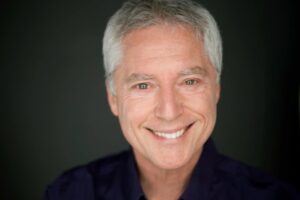 A prodigious writer and lecturer, Wallace manages to achieve both a depth and simplicity that is uncommon.
A prodigious writer and lecturer, Wallace manages to achieve both a depth and simplicity that is uncommon.
One reason that his work is so refreshing is due to its originality: he is happy to talk about traditional Buddhist practices that we don’t readily encounter. He’s also a member of the Mind & Life Institute.
Spirituality teachers are a bit like old cardigans. We’ve all got our favorite and they’re a unique and individual source of comfort to us.
With that in mind, this list is in a sense a personal one. I should really have phrased the title, “Ten Spiritual Teachers to Learn From In My Opinion”. It just didn’t have quite the same ring….
References
2. Images: Matthieu Ricard; Dalai Lama; Eckhart Tolle; Thich Nhat Hanh; Ken Wilber; Thomas Keating; Tara Stiles; B. Alan Watts
